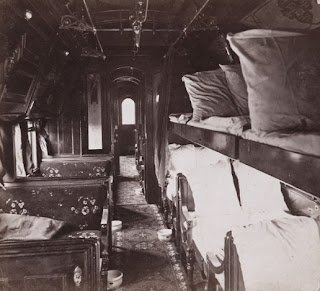 Major cities, and many smaller ones, were serviced by multiple railroads, usually running along somewhat different routes. And each railroad ran many different trains. So figuring out the best route between two cities could be difficult. The bible of rail travel was The Official Guide of the Railways. Several of these are online, including a 1904 edition at Google Books. Under listings for each railroad it has schedules for every passenger train. Finding the schedule for trains between New York and Albany on the New York Central is fairly easy. But for smaller cities on less prominent routes, it can be time-consuming. And comparing trains on different railroads can also be difficult. I imagine most people going on complex trips relied on a railroad or other agent.
Major cities, and many smaller ones, were serviced by multiple railroads, usually running along somewhat different routes. And each railroad ran many different trains. So figuring out the best route between two cities could be difficult. The bible of rail travel was The Official Guide of the Railways. Several of these are online, including a 1904 edition at Google Books. Under listings for each railroad it has schedules for every passenger train. Finding the schedule for trains between New York and Albany on the New York Central is fairly easy. But for smaller cities on less prominent routes, it can be time-consuming. And comparing trains on different railroads can also be difficult. I imagine most people going on complex trips relied on a railroad or other agent.Passenger fares were rarely published, but seem to have been approximately two cents per mile, so a one-hundred-mile journey would be about $2, equivalent to $50-$100 today, depending on how you compare prices. I don't believe express trains generally cost any more. But by stopping in only a few cities, they did shave a great deal of time off a trip. Limiteds were usually the fastest expresses. With limiteds, at some stops passengers could only board, and at others, only disembark. This shaved off a little more time. For instance, on the New York, New Haven and Hartford (NYNH&H), an express from New York to Boston took about six hours and a limited about five hours.
On the larger railroads, expresses usually had Pullman parlor cars. These cars were owned by the Pullman Company and leased to the railroads. Pullman maintained the cars and the porters manning them were Pullman employees. Most sleeping cars in 1900 were coaches that converted into sleepers. The facing seats combined into a berth and a second, upper, berth folded down from compartments that looked similar to the overhead storage bins on planes. In the photo at right, one side is made into berths, while the other is still configured as a coach. Privacy was obviously problematic.
These cars were also usually Pullman-owned and travelers paid an additional $2-$3 for the privilege. That's about what a room would run in a nice, but not expensive, hotel.
 Travelers between coastal cities could usually opt to take a steamship. These boats plied the Great Lakes and ran all up and down the East Coast. The 1903 Appletons' Dictionary of Greater New York lists more than a hundred routes between New York and other cities. Most are to nearby cities, but others serviced Boston, Washington, and Savannah. The steamship routes usually paralleled railroad routes, and the cost was comparable. For instance, a ticket on the NYNH&H from New York to Boston would run about $5. That's about what a cabin on a steamship would run, though there was also a $3 option if you would forgo the cabin.
Travelers between coastal cities could usually opt to take a steamship. These boats plied the Great Lakes and ran all up and down the East Coast. The 1903 Appletons' Dictionary of Greater New York lists more than a hundred routes between New York and other cities. Most are to nearby cities, but others serviced Boston, Washington, and Savannah. The steamship routes usually paralleled railroad routes, and the cost was comparable. For instance, a ticket on the NYNH&H from New York to Boston would run about $5. That's about what a cabin on a steamship would run, though there was also a $3 option if you would forgo the cabin.The chief difference was that the trains were much faster. As I mentioned above, the Limited to Boston took just five hours. The steamship took closer to twenty. The trains also ran much more frequently. I assume most people opting for the steamship simply saw it as a more pleasant way of traveling. Which explains why many of the nearby routes offered excursion fares. The routes up the Hudson were especially popular with day-trippers.

No comments:
Post a Comment
Note: Only a member of this blog may post a comment.